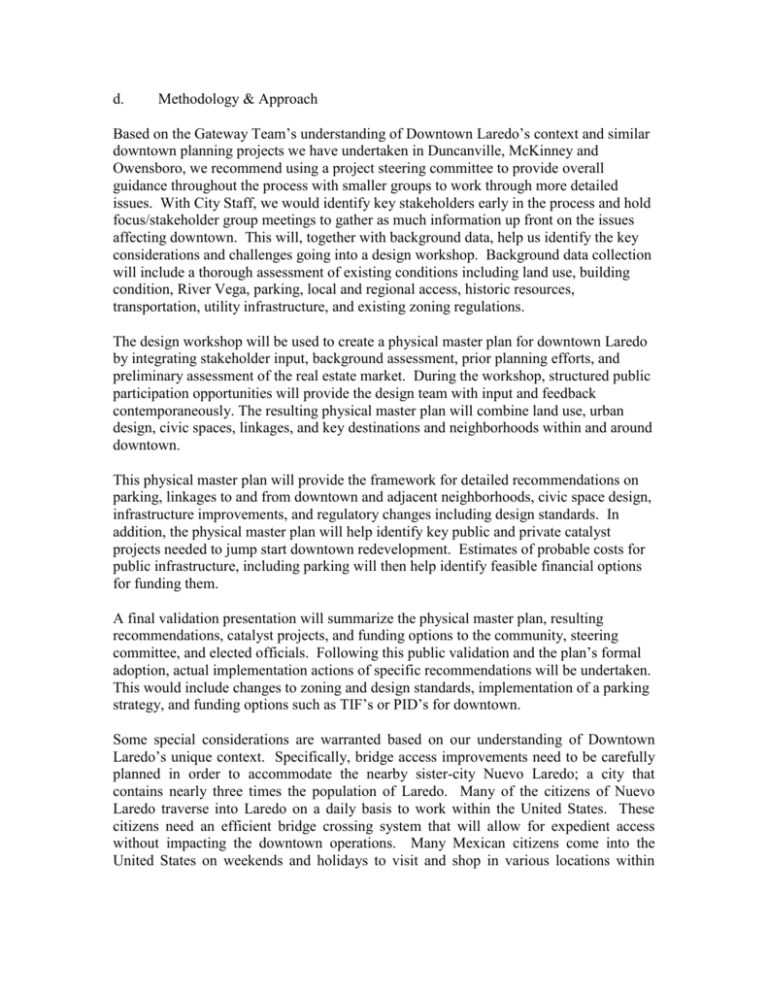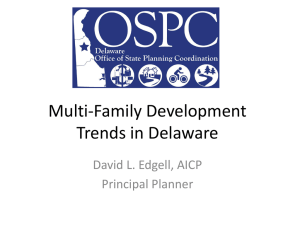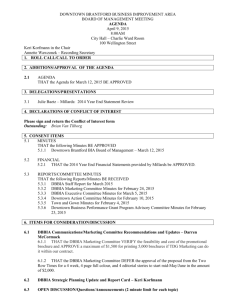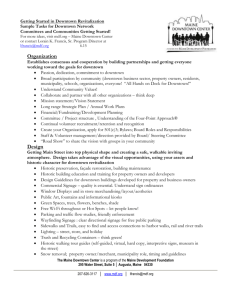section d and e
advertisement

d. Methodology & Approach Based on the Gateway Team’s understanding of Downtown Laredo’s context and similar downtown planning projects we have undertaken in Duncanville, McKinney and Owensboro, we recommend using a project steering committee to provide overall guidance throughout the process with smaller groups to work through more detailed issues. With City Staff, we would identify key stakeholders early in the process and hold focus/stakeholder group meetings to gather as much information up front on the issues affecting downtown. This will, together with background data, help us identify the key considerations and challenges going into a design workshop. Background data collection will include a thorough assessment of existing conditions including land use, building condition, River Vega, parking, local and regional access, historic resources, transportation, utility infrastructure, and existing zoning regulations. The design workshop will be used to create a physical master plan for downtown Laredo by integrating stakeholder input, background assessment, prior planning efforts, and preliminary assessment of the real estate market. During the workshop, structured public participation opportunities will provide the design team with input and feedback contemporaneously. The resulting physical master plan will combine land use, urban design, civic spaces, linkages, and key destinations and neighborhoods within and around downtown. This physical master plan will provide the framework for detailed recommendations on parking, linkages to and from downtown and adjacent neighborhoods, civic space design, infrastructure improvements, and regulatory changes including design standards. In addition, the physical master plan will help identify key public and private catalyst projects needed to jump start downtown redevelopment. Estimates of probable costs for public infrastructure, including parking will then help identify feasible financial options for funding them. A final validation presentation will summarize the physical master plan, resulting recommendations, catalyst projects, and funding options to the community, steering committee, and elected officials. Following this public validation and the plan’s formal adoption, actual implementation actions of specific recommendations will be undertaken. This would include changes to zoning and design standards, implementation of a parking strategy, and funding options such as TIF’s or PID’s for downtown. Some special considerations are warranted based on our understanding of Downtown Laredo’s unique context. Specifically, bridge access improvements need to be carefully planned in order to accommodate the nearby sister-city Nuevo Laredo; a city that contains nearly three times the population of Laredo. Many of the citizens of Nuevo Laredo traverse into Laredo on a daily basis to work within the United States. These citizens need an efficient bridge crossing system that will allow for expedient access without impacting the downtown operations. Many Mexican citizens come into the United States on weekends and holidays to visit and shop in various locations within south Texas. These citizens would not have to travel far if the downtown area were redeveloped into a more modern and attractive place with retail and entertainment. As with any historic city, there are numerous significant landmarks of American and Mexican history within the downtown area of Laredo. These landmarks need to be magnified and cultivated in order to maintain the uniqueness of culture and character within the city of Laredo. Potential utility issues within the downtown area include the need to properly maintain and regulate sewer line usage, addressing overhead utility overlaps at intersections, improving upon the existing storm sewer lines, locating and protecting all gas lines, and possibly implementing new fiber optic lines for better traffic signal synchronization and communication. With the gang-related violence occurring just across the bridge in Nuevo Laredo, it is extremely important to consider increasing the police presence of the downtown area. If there ever is a “spill-over” affect of this hostility into the United States, the first area to be impacted would be the downtown area. Hence there is a need to take a proactive approach rather than a reactive approach to protect the downtown area. e. Scope of Work, Deliverables, and Schedule Based on our understanding of the project and approach, we propose the following tasks, deliverables, and schedule: Task 1. Preliminary Assessment: A preliminary assessment of existing built environment, infrastructure/ utility capacity, transportation network, and market conditions. 2. Steering Committee: At the same time a stakeholder steering committee will be established and convened on a regular basis to transition from the visioning to implementation so that the 14 key components can be effectively considered. 3. Stakeholder Interviews: From the initial assessment, outreach to major property owners and businesses will commence announcing the initiative and setting initial meetings of stakeholders to secure early buy-in and to relate the 14 key components of the plan across linked issues. Deliverables Preliminary assessment report of current conditions as inputs to Master Plan 4. Regulatory Context: A full assessment of the planning and zoning regulations, design, policy and taxing structure environment shall be undertaken to assess the full potential of utilizing a form-based environment needed to create value capture through tax incentives and other mechanisms such as Tax Increment Financing; in parallel, the Capital Improvement Program will be assessed, including long term financing capacity and any major infrastructure gaps under the current conditions. 5. Market Analysis: Developed as a capacity analysis in terms of aggregate potential in downtown by uses and evolving market opportunities, an initial trends market analysis and Schedule Month 1-2 Month 1 Work with city staff to establish a steering committee agenda and meeting schedule. Assist city staff in facilitating steering committee discussions. Work with city staff and Month 2 steering committee to identify key stakeholder groups and schedule meetings. Conduct stakeholder meetings and summarize input to inform the master plan. Month 2-3 Summarize regulatory and public financing assessment to inform the master plan process Develop a market analysis report that identifies the potential for downtown land uses. Month 3 development scenario will be determined. 6. Railroad Strategy: An assessment of railroad conflicts, border crossing impacts (vehicular and pedestrian), existing circulation studies, parking, connectivity and pedestrian environments will be undertaken in context of critical linkages, current destinations, future development opportunities 7. Downtown Housing: An assessment of current downtown housing environments, current liabilities and desirability for housing to determine realistic downtown housing goals; key catalytic housing opportunities and tools and incentives for housing including public/private partnerships. 8. Convention Center & Civic Buildings: An assessment of a downtown convention center and other key existing or potential future civic buildings will be undertaken in context of demand, capacity, development impacts, design considerations, financing options and public-private partnership potential. 9. Interim Worksession: A City Council Worksession will be held to receive feedback on the initial conclusion drawn from the data collection and analysis 10. Community Charrette: Upon completion of the initial assessment tasks and feedback from the City Council Worksession, a community charrette will be held to develop a refined vision for downtown reflected in a building-scale master plan; the results of the community charrette will be used to develop the implementation initiative for downtown Start to develop a critical path plan and framework to work with TxDOT, US Border Patrol, and Union Pacific railroad on critical linkage issues pertaining to downtown. Month 2-4 Develop a preliminary assessment of downtown housing opportunities and issues. Month 3-4 Assessment to be Month 3-4 included in the market analysis report from Task 5 Preliminary report City Council Conduct a Community Month 5 Charrette to create a physical master plan for downtown and gather community and stakeholder feedback during the Charrette. Summarize Charrette outcomes and refine master plan based on community input. Preliminary assessment Month 6 of fiscal impact and 11. Fiscal Impact and Financing: Based on the building scale master plan, a to Month 4 fiscal impact analysis will compare trends development to redevelopment growth under the initiative, generating tax incentive capacity for downtown; the resulting delta of increased value net of cost of service under the respective predicted futures will be used to support recommendations for initial catalytic projects. 12. Form-Based Framework: Utilizing the Master Plan and assessment of the existing regulatory environment, a form-based code framework will be crafted to implement the downtown vision through a market-based regulatory environment that increases value capture potential. 13. Staff Worksession: A staff worksession will be held to review the form-based framework and value capture strategy. 14. Integrated Implementation: Additional implementation elements will be finalized in terms of economic development, comprehensive downtown transportation strategy, neighborhood linkages, CIP, convention center, etc.; the elements will be folded into a comprehensive implementation plan including refinement of a downtown management structure. 15. Council worksession: A council worksession and public meeting will be held to receive feedback on draft implementation plan and form-based code framework. 16. Develop Form-Based Code: Develop a draft form-based code based on council and community approved framework financing including recommendations for public-private partnerships and catalyst projects Develop a framework Month 6-7 for a form-based code to implement the master plan including identifying character zones and major defining features. Revise form-based code Month 7 framework based on staff input. Develop draft Month 7-8 Implementation Plan encompassing all critical elements. Revise plans based on Month 8 Council and public input received. Develop detailed form- Month 9 based code standards including a regulating plan and development, design, and historic preservation standards for different downtown character zones. Final master plan report Month 10-11 17. Formal Adoption and Approval: Revise Master Plan, Implementation plan, and Form-based code and support final approval and adoption. and form-based code



